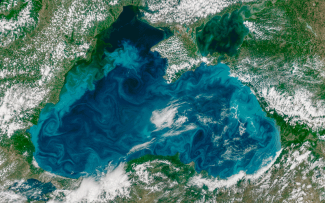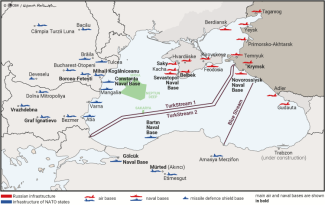Romania, Bulgaria and Turkey in the Black Sea region: increased cooperation?

The Russian Federation’s full-scale invasion of Ukraine has heightened security risks for NATO allies in the Black Sea region, namely Romania, Bulgaria and Turkey. These countries differ in how they perceive the challenges and threats, as well as in how they have responded to them. Romania views Moscow as the main military threat and has long sought to internationalise the issue of Black Sea security. Bulgaria, which officially recognised the threat posed by Russia only after 2022, appears to be the most passive NATO member in this context. Turkey sees Russia as a challenge, though not a direct threat, and continues to pursue bilateral economic cooperation with Moscow. Ankara prioritises military involvement in other strategic areas and has been reluctant to significantly increase NATO’s presence in its immediate neighbourhood.
It was only in 2024 that a shared interest in combating sea mines that reduce maritime security in the Black Sea drove the three countries to initiate trilateral military cooperation. In theory, the adoption of NATO’s regional defence plan for Southern Europe in 2023 was expected to strengthen this cooperation, but in practice no such effects have materialised.
Romania, Bulgaria, and Turkey will nevertheless need to adjust their policies to address new challenges: the potential reduction of the United States’ military presence in the region, concerns over how the war in Ukraine may end, and the continued expansion of Russia’s military capabilities. These countries face the necessity of taking on greater responsibility for defence and deterrence in this part of the continent, in coordination with the Western European allies who may increasingly be a substitute for US involvement. This will require faster and more substantial investments in their own military capabilities, as well as closer regional cooperation.
Different perspectives of looking at regional security
Romania considers the Black Sea a key area from the standpoint of both its national security and economic interests, and views Russia as the primary threat there. This perspective was reinforced by Russia’s invasion of Ukraine in 2022 and, earlier, the annexation of Crimea in 2014. These developments have reduced the de facto distance between the borders of Romania and Russia from 500 to 200 kilometres. Consequently, Romania’s main air force base near Constanța came within range of Russian air defence and missile systems deployed in Crimea. The Black Sea also holds fundamental importance for Romania’s trade and energy sectors. Romania operates the largest harbour on the Black Sea (in Constanța) and exploits natural gas resources within its exclusive economic zone (EEZ), albeit so far on a limited scale.
The intention articulated by Moscow after 2022 to gain control over Ukraine’s Odesa Oblast has raised concerns in Bucharest that Russia could eventually secure access to the Danube Delta and block this critical artery for regional trade. Additionally, Romania sees Russia as its main rival in the struggle for influence in Moldova.[1] Aware of its limited capacity to project power in the Black Sea basin, particularly in its maritime domain, Romania is seeking to internationalise regional security issues. This primarily involves increasing the presence of allied forces, especially in the maritime and air domains.
For Bulgaria, the Black Sea is primarily important from an economic perspective, especially in the tourism sector which accounted for nearly 7% of the country’s GDP in 2023. For many years, Bulgaria did not perceive Russia as a military threat, and successive governments sought to maintain good relations with it, largely due to historical and cultural ties. A shift in this approach did not occur until after the full-scale invasion of Ukraine, which prompted Bulgaria to accelerate the modernisation of its armed forces, including those tasked with defending the coastline. Although the political elites remain divided on how to assess the threat posed by Russia, strategic documents, such as the 2025 National Defence Strategy,[2] identify it as the primary danger to the state. However, Bulgaria’s persistent political instability, with seven parliamentary elections held since 2021, continues to hamper its ability to devise an effective response to the evolving regional security environment.
Russian activities in the Black Sea also have an impact on local energy projects aimed at exploiting natural gas resources located in Bulgaria’s EEZ in the Black Sea. In 2023, Russia blocked access to this area under the pretext of conducting naval military exercises, an act that Sofia regarded as a provocation.
Turkey’s Black Sea strategy aligns with its broader policy of balancing between Russia and the West. Ankara aims to avoid any military escalation that could trigger a war between NATO and Russia, which would risk drawing Turkey itself into an armed conflict in the region. At present, it does not perceive a direct military threat from Russia, but considers it a competitor in the neighbourhood. A possible end of the war to Ukraine’s disadvantage, along with the potential seizure of its southwestern territory, is causing concern in Turkey over the Kremlin’s growing military dominance. Turkey’s decision to close the Black Sea straits in February 2022 under the Montreux Convention[3] for both warring parties (Russia and Ukraine) prevented Russia from reinforcing its naval presence in the Black Sea.
Ankara seeks to preserve the current balance of power in the Black Sea and remains reluctant to support a greater NATO naval presence in the area. For the Turkish government, despite broader rivalry with Moscow in the South Caucasus, Libya, and – until recently – Syria, Russia remains an important economic and energy partner. Avoiding military escalation in the region also enables the Turkish navy to allocate more attention and resources to the Middle East and Africa, where Ankara is striving to maximise its political, economic, and military influence. The Turkish navy is present in Libya, Somalia and Qatar, in addition to maintaining a permanent presence in Turkey’s EEZ in the Mediterranean and Aegean Seas. In the event of conflict in the Black Sea region, Turkey would need to reinforce its forces in that theatre, thereby reducing its military engagement in other parts of the world.
The military potential and modernisation priorities
Romania and Bulgaria are developing their armed forces within NATO’s defence planning framework to deter and defend against any potential aggressive moves by Russia towards the alliance. Due to financial constraints, both countries are primarily focusing on their air and land forces, placing less emphasis on their naval capabilities. Turkey, on the other hand, does not perceive itself as a state on NATO’s eastern flank and is expanding its military potential not only within the context of the alliance. It has the second-largest army in NATO, and its modernisation and reforms reflect its ambitions to pursue an active and multi-vector foreign and security policy. Turkish ground forces are conducting operations on the territory of its southern neighbours (in Syria and Iraq) against the Kurdish terrorist organisation PKK and affiliated groups. Turkey strikes a balance between seeking ‘strategic autonomy’ in the politico-military sphere and fulfilling its NATO obligations; this periodically gives rise to crises in relations with its allies.
Romania’s defence spending (with its armed forces numbering, according to various sources, between approximately 66,000 and 80,000 active-duty personnel) ranged from 1.35% to 1.84% of GDP between 2014 and 2019. It has reached the 2% GDP benchmark only twice so far – first in 2020, and again in 2024 (from 2021 to 2023, the defence ministry’s budget amounted to around 1.7%). Bucharest is focusing on developing its air force (through the procurement of fourth- and fifth-generation F-16 and F-35 fighter jets)[4] and on a comprehensive modernisation of its land forces (including armoured personnel carriers, tanks and artillery).[5] It is also investing in medium-range air defence systems such as the Patriot[6] and coastal defence systems capable of striking naval targets from land using NSM missiles.[7] Until recently, naval expansion was not treated as a priority, so the navy’s capabilities remain limited. One of Bucharest’s key objectives is to maintain the safety and low cost of commercial shipping in the Black Sea. After drifting Russian and Ukrainian sea mines became the greatest security threat from 2022 onwards, Romania – which had until then possessed only minimal mine countermeasure capabilities – decided to acquire two second-hand minehunters. In 2025, it initiated the procurement process for a corvette, and the government has declared further investments.[8]
For many years, Bulgaria allocated between 1.3% and 1.5% of its GDP to military purposes (with the exception of 2019, when defence spending rose to 3.1% of GDP due to the purchase of F-16 fighter jets). However, after 2022, it increased its defence expenditure, which reached 2.04% of GDP in 2024. The size of its armed forces is estimated at between 25,000 and 33,000 active-duty personnel, depending on the source. At the same time, Sofia has taken steps to modernise its military and reduce its dependence on Russian spare parts for the Soviet-era equipment which it still uses. These efforts are gradually extending to the navy and air defence systems as well, although years of neglect in these areas mean that significant improvements cannot be achieved in the short term. The main defence investments focus on the air force – notably the procurement of F-16 fighter jets[9] and IRIS-T SLM short-range air defence systems.[10] In the Black Sea, Sofia’s top priority is tackling threats posed by sea mines.
The Bulgarian navy operates a fleet of outdated vessels with limited combat capabilities. In 2023–2024, two patrol ships were launched in Varna and they will eventually be equipped with Swedish RBS-15 anti-ship missiles. They are scheduled to enter service in 2025 and 2027, respectively. A decision has yet to be made, however, regarding the purchase of new missiles for the land-based coastal defence systems (NSM or RBS-15 are under consideration).
Before 2022, Turkey spent only 1.3–1.85% of its GDP on defence, mainly due to economic difficulties. However, in 2024, defence spending rose to 2.09% of GDP. For many years, Ankara has been implementing a comprehensive programme to modernise its armed forces, combined with the development of a defence industry capable of producing key weapons and military equipment for all the branches of the national military and for export. As part of this effort, it is upgrading its air force, including modernising about 150 of its 236 F-16 fighter jets and planning to purchase 49 new ones, while also seeking a replacement.[11] In the longer term, it is developing its own fighter jet, the TF KAAN, which aspires to be a fifth-generation aircraft. The Turkish air force operates an extensive and advanced drone fleet, manufactured using various indigenous platforms. In the land forces (with around 355,000 active-duty troops), there is a generational overhaul of combat vehicles underway, including Altay tanks, Kirpi, Kaplan, and Pars armoured vehicles, T-155 Fırtına howitzers, and unmanned ground vehicles. The navy is advancing its MILGEM programme, which includes domestically produced Ada-class corvettes and frigates equipped with Atmaca anti-ship missiles. It has also commissioned the TCG Anadolu amphibious assault ship, which was originally intended to operate F-35B jets. However, due to Turkey’s exclusion from the F-35 programme, its naval aviation component currently relies solely on drones. Turkey also plans to build its own submarine under the MILDEN programme. The country’s air defence is currently based on a large number of outdated short-range HAWK and Rapier systems, which will be replaced by the domestically developed short- and medium-range HİSAR and SIPER systems.[12] Ankara is also developing its own short-range ballistic missiles (Bora) and cruise missiles (Çakır).
NATO and trilateral military cooperation in the region
Since Romania and Bulgaria joined NATO in 2004, allied activity in the Black Sea region has primarily consisted of using their military bases to support US operations in the Middle East and Africa. In 2010, both countries began hosting the rotational presence of the US Marine Corps (Black Sea Rotational Force), and in 2014, the US launched the Aegis Ashore missile defence base in Deveselu, Romania, as part of NATO’s missile defence system.[13]
Despite persistent efforts, since 2014 Romania has failed to establish a Black Sea naval task force or to secure the permanent rotational presence of allied battalion battlegroups on its territory – NATO decided only to deploy a small training mission there.[14] However, an enhanced air policing mission over Romanian and Bulgarian airspace was launched. Between 2014 and 2022, British and American navy destroyers conducted annual freedom of navigation exercises in the Black Sea, involving joint patrols with Turkish, Romanian, and Bulgarian vessels, port visits to Odesa, and transits through Crimean territorial waters. In 2022, NATO significantly increased its presence in the region. Four new battlegroups were established[15] with France as the framework nation in Romania,[16] and Italy in Bulgaria. In 2023, the Black Sea area was incorporated into a new NATO regional defence plan, which also covers Southern Europe, the Mediterranean, and Turkey.
In recent decades, the United States has been the most actively engaged NATO member in strengthening security in the Black Sea basin. Its presence is concentrated in Romania, where approximately 1,800 US Army soldiers (an infantry brigade) are currently stationed; during 2022–2023, this number reached up to 3,000. Since the end of 2021, US reconnaissance, surveillance, command and control aircraft, and drones have maintained an almost constant presence over the waters of the region. The largest international military exercises in the area are the biennial US-led Saber Guardian drills, conducted as part of the broader DEFENDER Europe manoeuvres. In the 2023 edition, over 2,400 US troops and 7,300 soldiers from other countries (including Romania, Bulgaria, France, and Italy) took part.[17]
Romania has long sought to expand the US and NATO military presence in this part of the world.[18] Even before the 2016 NATO summit in Warsaw, it had unsuccessfully proposed initiatives calling for the stationing of allied ground forces and the creation of a Black Sea fleet. Prior to 2022, Turkey and Bulgaria were sceptical of such proposals, driven by concerns over worsening relations with Russia and heightened tensions in the region. However, the experience of the war in Ukraine convinced Sofia of the necessity of greater NATO engagement. Turkey, too, did not oppose the land presence of NATO forces in Romania and Bulgaria and supported the alliance’s defence plans for the region. As NATO‘s strongest member in the Black Sea area in military terms, it also participated in the enhanced airspace surveillance missions over both countries and contributes around 200 troops to the NATO battlegroup in Bulgaria. Nevertheless, out of concern for growing tensions, Turkey has consistently emphasised the need to avoid escalation, to maintain dialogue with Russia, and adhere to the Montreux Convention, which limits the presence of allied forces in the Black Sea.[19]
Before the Russian-Ukrainian war began, Turkey, Romania and Bulgaria participated in multilateral military cooperation formats in the Black Sea basin. In the land domain, they were part of the South-Eastern Europe Brigade (SEEBRIG), alongside countries such as Greece and Italy, which promoted regional cooperation and interoperability. In the maritime domain, along with other littoral states (including Russia and Ukraine), they had been members of the Black Sea Naval Force and took part in the Black Sea Harmony operation, both aimed at countering terrorism and asymmetric threats in the region. However, these initiatives ceased functioning after 2014. It was only following Russia’s full-scale aggression against Ukraine that trilateral cooperation among NATO Black Sea states began to emerge. In 2024, the Turkish-Bulgarian-Romanian mine countermeasures task group, MCM Black Sea (Mine Countermeasures Black Sea Task Group), was launched. Its mission is to eliminate the threats to maritime safety in the Black Sea posed by drifting naval mines.
What is the future of deterrence and defence in the region?
Russia’s invasion of Ukraine and its territorial gains have strengthened its military position in the Black Sea basin. By creating a land corridor to Crimea through the occupation of parts of Ukraine’s Kherson, Zaporizhzhia, and Donetsk oblasts, Russia has improved its ability to sustain and support forces operating from the peninsula logistically. This has, in turn, enhanced its power projection capabilities in the air and maritime domains. Any further conquests of Black Sea coastal territories would not significantly affect Russia’s regional capabilities in those domains. However, the occupation and continued militarisation – particularly through the construction of reconnaissance and strike systems – of Ukraine’s Snake Island in the Black Sea would be especially problematic due to its proximity to Romania’s coast. The establishment of a Russian-Romanian land border, although this is currently unlikely, would constitute a profound change from the perspective of both Romania and NATO as a whole.
The potential reduction of the US military presence in Europe, as signalled by Donald Trump’s administration, could have significant consequences for the Black Sea region, particularly for Romania. The question of whether US engagement in reconnaissance, surveillance, and airborne command and control – especially in support of Kyiv but this is also vital for the entire alliance – will be maintained remains unresolved. In light of this uncertainty, as well as open-ended issues surrounding the conclusion of the war in Ukraine and the ongoing expansion of Russia’s military capabilities, NATO’s Black Sea members will need to assume greater responsibility for regional defence and deterrence, in close cooperation with their European allies. This implies an accelerated and increasing investment effort both in the modernisation and expansion of their own capabilities and in enhanced cooperation with neighbouring countries.
Romania should be particularly interested in the effective implementation of its ongoing programmes aimed at expanding ground-based coastal defence systems and air power capabilities. In the worst-case scenario, Bucharest would not only need to accelerate the modernisation of its land forces but also consider increasing their overall size. Additionally, the government would be compelled to revisit an idea it abandoned in 2023 : the acquisition of at least two new corvettes, as enhancing naval capabilities (both in quantitative and qualitative terms) will become an increasingly pressing issue. This urgency stems in part from planned energy projects in the Black Sea region, which will require military protection to ensure their security.[20] Moreover, any potential reduction in the US presence in the region will elevate the importance of France’s military involvement in Romania.
It is in Bulgaria’s interest to continue modernising its land and air forces. However, due to internal political instability[21] and financial constraints, it is difficult to predict Bulgaria’s approach to strengthening regional security. It will likely remain reactive, adapting to the actions of larger neighbouring players. However, the continuation of the war or a Russian victory may compel Bulgaria to redirect some of its resources towards its underfunded navy in order to better protect its energy infrastructure in the Black Sea.[22] Given the budgetary limitations, both Bucharest and Sofia will be unable to significantly or rapidly expand their air power capabilities and, as a result, will have to rely on their allies – including Ankara – for support.
Turkey is the only NATO country in the Black Sea region that has the air and naval capabilities necessary to fill the potential gaps left by a withdrawing US military presence, though this would require further investment and expansion. A Russian victory in the war in Ukraine would also pose a challenge for Ankara, as Moscow would likely increase its military presence in the Black Sea basin. In the event of heightened tensions in the region, Turkey would likely be prepared to boost the deployment of its own naval and air forces. However, doing so would necessitate both the redirection of military resources from other strategic theatres and a reassessment of its role in the Black Sea, as well as an at least partial revision of its balancing policy between NATO and Moscow. At the same time, in order to avoid confrontation and to preserve its extensive energy cooperation with Russia (including gas imports and joint nuclear energy projects), Turkey will aim to prevent any escalation.
Romania, Bulgaria, and Turkey will have to extend their cooperation in the Black Sea basin within NATO by implementing the obligations of the regional defence plan, which covers Southern Europe, including the Black Sea. This should translate into an increased amount of training and exercises involving these three countries and should foster closer bilateral and trilateral ties. The grounds to establish a joint coordination or crisis response centre may arise; this could be located in Constanța, Varna or Istanbul and would be responsible for monitoring maritime activity, sharing data, and responding to incidents, modelled along the lines of the Command Task Force Baltic (CTF Baltic) operating in the Baltic Sea. The European Union could also become a platform for supporting security in the Black Sea. In May 2025, the European Commission, together with the High Representative for Foreign Affairs and Security Policy, announced plans for a new strategy for the region. This includes the creation of a Black Sea Maritime Security Hub. The initiative aims to strengthen not only maritime security, as its name suggests, but also the protection of critical infrastructure by means of real-time information sharing, threat monitoring, and the coordination of mine countermeasure activities.[23]
Map. Military infrastructure and maritime energy infrastructure in the Black Sea region

Source: author’s own analysis.
[1] For more on the peculiarities of Romanian-Moldovan relations and on Moldova’s importance to Romania see K. Całus, In the shadow of history. Romanian-Moldovan relations, OSW, Warsaw 2015, osw.waw.pl.
[2] Национална отбранителна стратегия, Council of Ministers of the Republic of Bulgaria, 6 March 2025, strategy.bg.
[3] Article 19 of the convention stipulates that in time of war, Turkey not being belligerent, vessels of war belonging to belligerent powers shall not pass through the straits except when returning to their home bases in the Black Sea. Vessels belonging to other states enjoy complete freedom of transit and navigation through the straits.
[4] Romania signed an agreement with Norway for the purchase of 32 second-hand F-16 fighter jets (16 of them were delivered by March 2025). Deliveries of 32 F-35 jets are set to begin in 2031.
[5] Romania has purchased approximately 380 Piranha V armoured personnel carriers and 21 AAV-7 amphibious vehicles, 54 HIMARS rocket artillery systems, and 54 K9 self-propelled howitzers. It also plans to procure 54 M1A2 Abrams tanks and up to 200 K2 tanks.
[6] In 2017, the Romanian parliament approved the purchase of seven Patriot air defence systems. By mid-2024, the country had four batteries in service. The system transferred to Ukraine is to be replaced by a battery funded by allies. Romania is also expected to receive the remaining three contracted systems by 2029.
[7] Bucharest purchased two such systems with a range exceeding 100 nautical miles. Their delivery is scheduled for 2028.
[8] Romania also plans to modernise three small missile corvettes, which are to be adapted to carry NSM missiles.
[9] Bulgaria signed a contract to purchase a total of 16 F-16 Block 70 fighter jets. The first was delivered in 2025, and deliveries are scheduled to continue until 2027.
[10] Bulgaria purchased one IRIS-T SLM short-range air defence system, with an option to order five additional SLM batteries and one SLX battery (medium-range). Ultimately, these systems are intended to replace the Soviet-era S-300 and S-200 systems.
[11] In 2019, Turkey was excluded from the F-35 programme and later covered by CAATSA sanctions (in 2020) due to its purchase of the Russian S-400 air defence system. Currently, negotiations are underway regarding its potential return to the programme.
[12] Additionally, Ankara has two medium-range S-400 batteries purchased from Russia; however, they are not on active combat duty.
[13] J. Gotkowska, ‘NATO’s Eastern Flank – a new paradigm’, OSW, 13 July 2016, osw.waw.pl.
[14] In 2014, Bucharest established the Multinational Division Southeast Headquarters, which was integrated into NATO’s force structure. In 2017, Romania transformed one of its brigades into a multinational formation subordinated to this command. This brigade includes companies (including one from Poland) participating in the rotational allied land forces presence in Romania, primarily focused on training.
[15] J. Gotkowska, J. Tarociński, ‘NATO after Madrid: how much deterrence and defence on the eastern flank’, OSW Commentary, no. 462, 5 July 2022, osw.waw.pl.
[16] France maintains a permanent rotational presence of approximately 1,000 troops in Romania, including a tank company and a medium-range air defence battery equipped with the SAMP/T system.
[17] J. Tarociński, ‘Military exercises on NATO’s north-eastern flank. Moving towards intensification and synchronisation’, OSW Commentary, no. 563, 28 December 2023, osw.waw.pl.
[18] One of Romania’s most significant military infrastructure investments is the expansion of the Mihail Kogălniceanu Air Base near Constanța. The facility is primarily intended to accommodate allied forces, mainly American troops.
[19] Article 18 of the convention effectively limits the aggregate tonnage of vessels belonging to non-Black Sea powers in times of peace to 45,000 tonnes. Up to nine vessels belonging to non-Black Sea states with the aggregate tonnage up to 15,000 tonnes can pass through the straits at a time, and their stay in the Black Sea must not exceed 21 days. The Black Sea states are exempt from these limitations. In wartime, vessels belonging to other non-belligerent states maintain the right to use the straits, albeit this is subject to Ankara’s consent, among other things (Article 21). After 2022, Turkey has publicly voiced its reluctance to allow such passage.
[20] This is related to the upcoming launch of production at the Neptun gas field in the Black Sea and the implementation of planned undersea energy projects.
[21] See Ł. Kobeszko, ‘A country of interim governments. The political crisis in Bulgaria and the attempts to solve it’, OSW Commentary, no. 600, 3 June 2024, osw.waw.pl.
[22] This refers to the undersea cable system connecting Bulgaria with Romania and Turkey (KAFOS) and Georgia (Caucasus Cable System).
[23] ‘Joint communication to the European Parliament and the Council. The European Union’s strategic approach to the Black Sea region’, European Commission, 28 May 2025, ec.europa.eu.





